Introduction
With Contributions from
Shobana Kapyarath, ERP Analytics Product Manager, Oracle Analytics
Sushil Dhoot, Senior Principal Product Manager, Oracle Analytics
Oracle Fusion Data Intelligence (FDI) extends the value of Oracle Fusion Cloud Applications with packaged analytics to help monitor, align, and act on essential insights. Fusion Enterprise Resource Planning (ERP) Analytics provides numerous key metrics that help business monitor their financial performance.
FAW has General Ledger (GL) Balance Sheet and GL Profitability subject areas that provide Balance Sheet and Profit and Loss metrics. These metrics are derived from the prebuilt financial categories in ERP. It is essential to properly define the financial categories in ERP to ensure the Key Performance Indicators (KPIs) and metrics are accurately calculated. Customers have specific business needs that require them to build additional metrics. This blog describes one requirement that defines custom metrics using hierarchies defined in ERP.
Prerequisites
Ensure you have completed the prerequisite steps for ERP in FAW. See this article for complete details: https://blogs.oracle.com/analytics/post/prerequisites-for-oracle-fusion-erp-analytics
Use Case
The business must create a Gross Margin Report with Revenue, Cost of Goods Sold, and Gross Margin. The report has the following metrics, and this post walks through setting up the formula for each one. This blog focuses on creating a Gross Margin report by defining metrics using the Natural Account hierarchy defined in ERP.
Gross Margin Report
Revenue – Consulting
Revenue – Hardware
Revenue – Services
Revenue – Support
Revenue – Insurance
Revenue – Misc
Revenue – I/C
Total Revenue
Total Cost of Sales
Gross Margin
Oracle Fusion Cloud ERP (Fusion ERP) has only one financial category, “REVENUE”. The GL Profitability subject area uses this financial category to derive the Revenue metric for Profit and Loss. Customers must create custom metrics for a Gross Margin Report with revenue broken up by various revenue streams. This is achieved by creating custom metrics using custom financial categories or account hierarchies.
To create metrics based on custom financial categories, refer to the steps mentioned here: https://blogs.oracle.com/analytics/post/custom-general-ledger-metrics-in-fusion-analytics-warehouse-using-semantic-model-extensions.
To create custom financial categories for the various Revenue items, map the Natural Account codes to these custom financial categories and define the custom metrics.
The below screenshot shows the Natural Account hierarchy definition in Fusion ERP. Create a report in FAW using any GL-related subject area to see the hierarchy definitions.
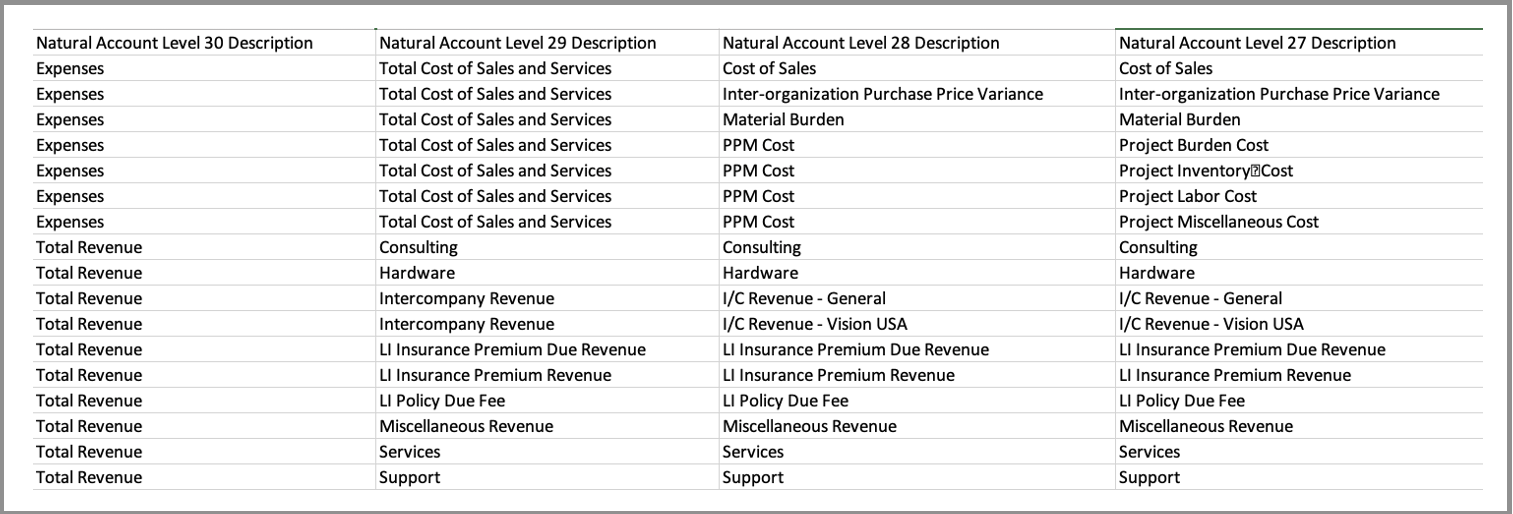
FAW Report Screenshot
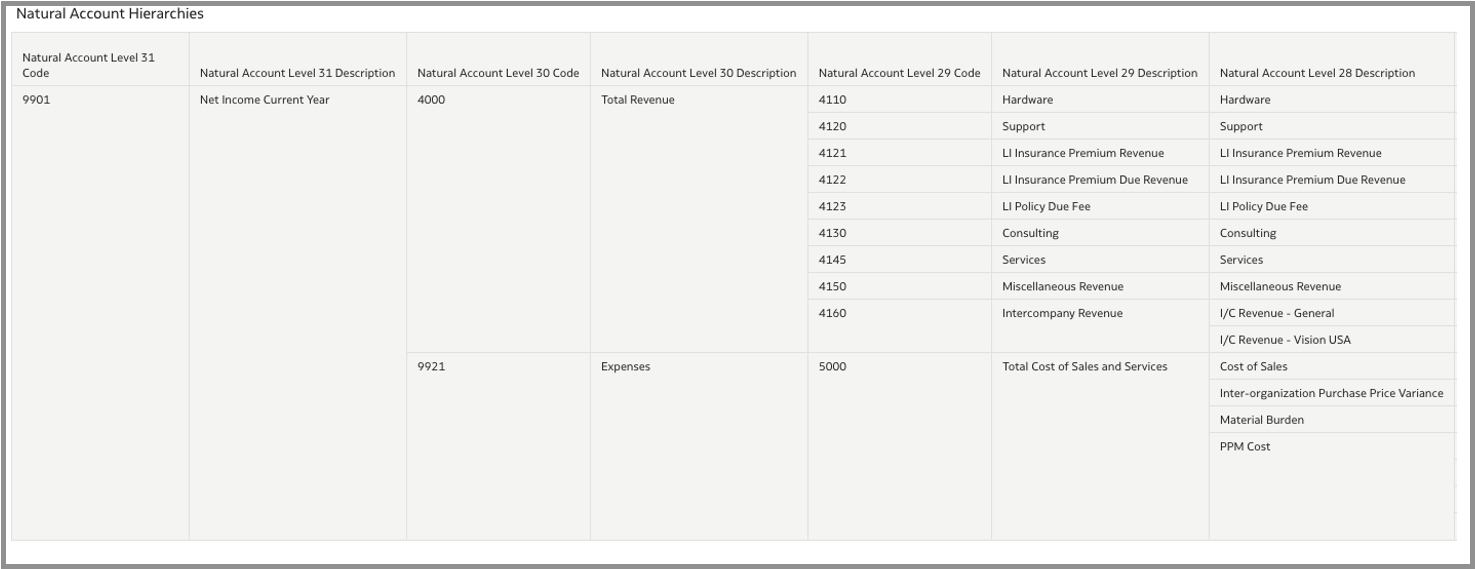
Once the Hierarchy Tree and Level Code are identified for use in the report, proceed with Semantic Model Extensions.
Semantic Model Extensions
This section shows how to use Semantic Model Extensions to create metrics based on the custom financial category.
- Log in to FAW with the Modeler role. For information on roles, see the Oracle Fusion Data Intelligence Administration Guide.
- Launch the FAW Console and click Semantic Model Extensions.
- Click Create Branch.
- Provide the Name and Description and click Done.
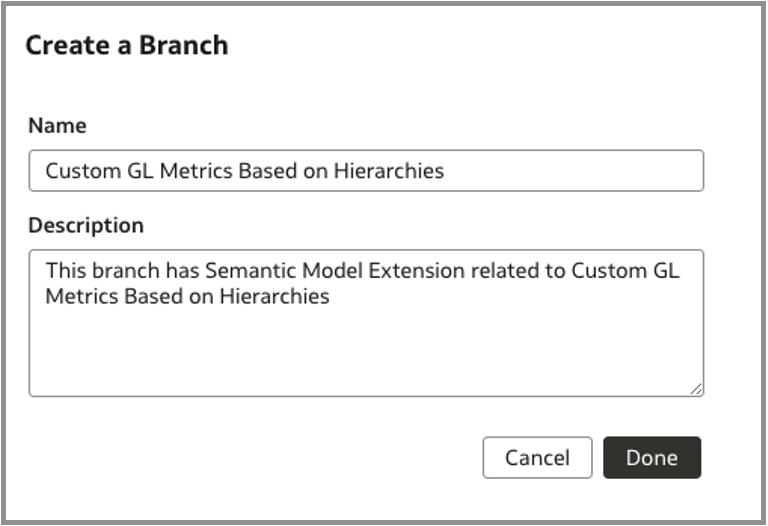
5. Click Add Step and select Create a Subject Area.
6. Create the subject area based on Financials – GL Profitability.
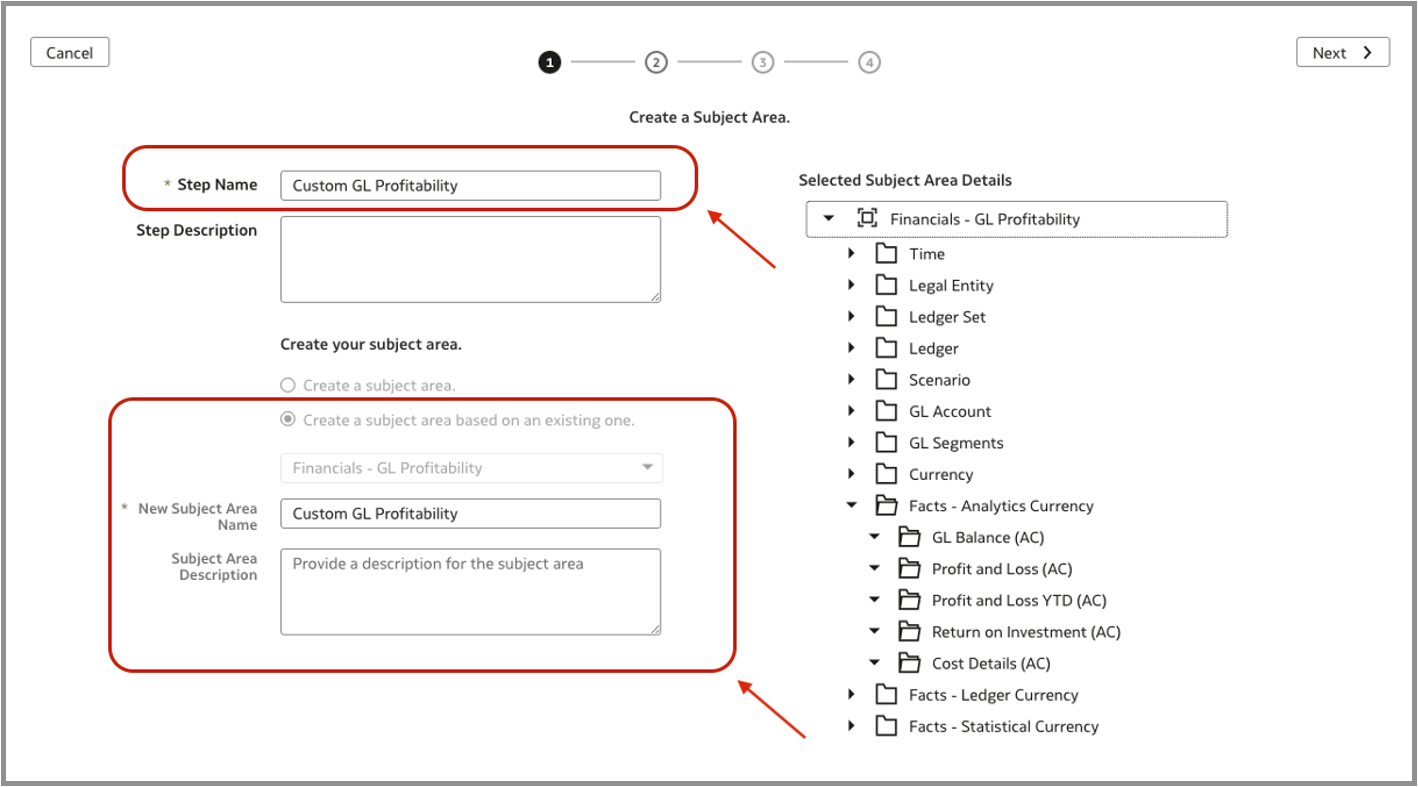
7. Select all data elements and click Next.

8. Click Next to proceed.
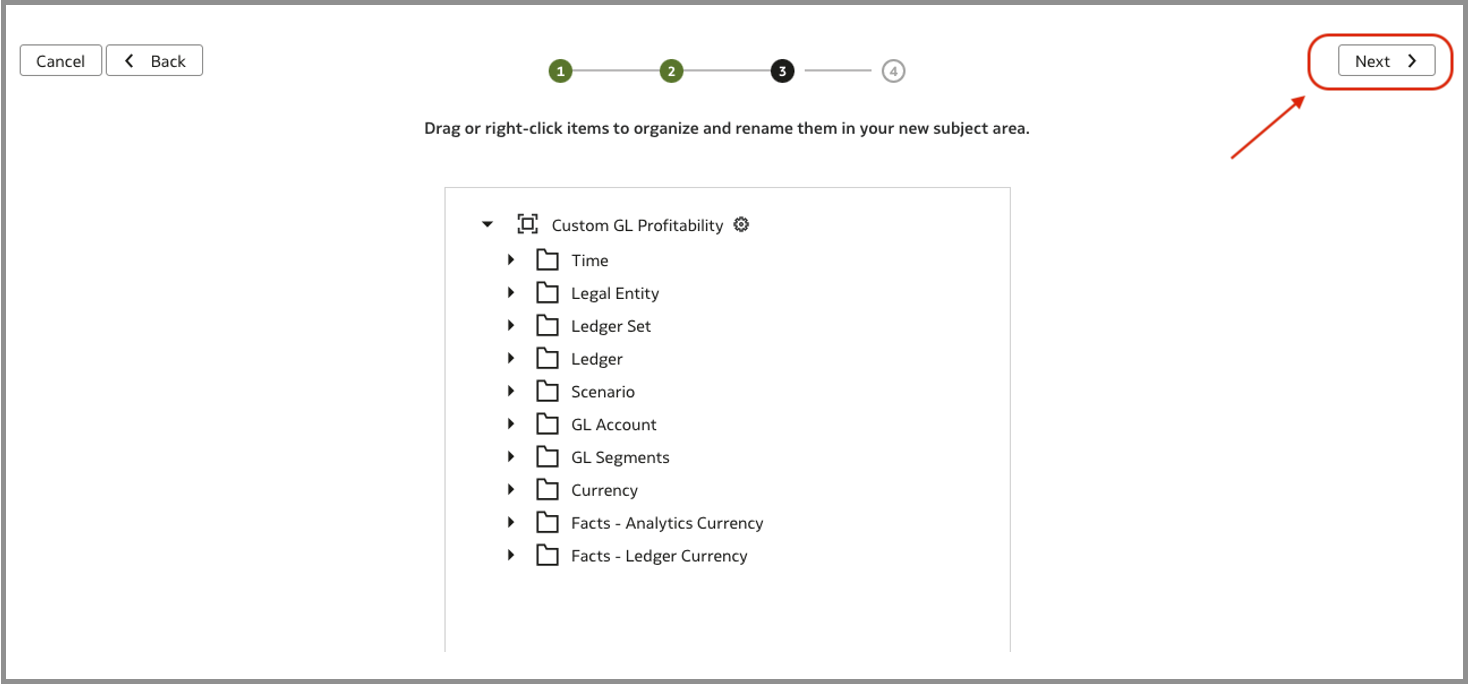
9. Click Finish.
10. Click Add Step and click Add Columns.

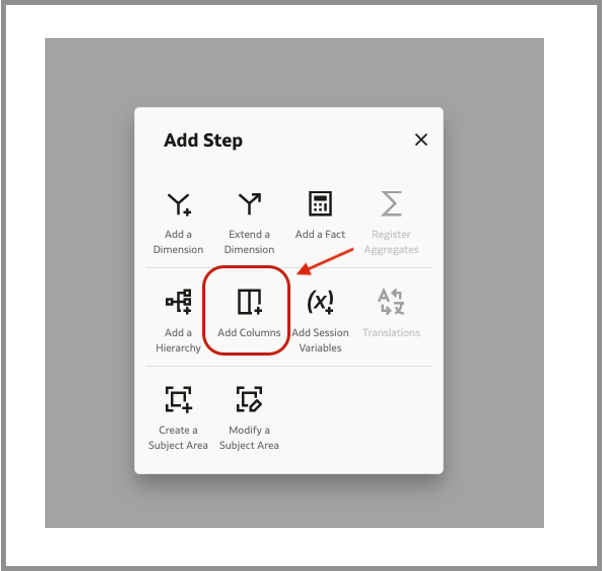
11. Select the following options from the dropdowns and click Next:
Target Subject Area = Custom GL Profitability
Folder = GL Balance (AC)
Logical Table = Fact – Fins – GL Balance

Create a Metric Column
- Create a Revenue – Consulting metric using the Natural Account hierarchy definition shown earlier.
- Enter the following into the formula:
IFNULL (FILTER ("Core"."Fact - Fins - GL Balance"."Activity Amount in Analytics Currency"*(-1) using "Core"."Dim - Natural Account Hierarchy"."Natural Account Level 29 Code" = '4130'),0)

3. Click Validate and then click Save.
Note: The Natural Account Level used in the metric definition, e.g., Natural Account Level 29 Code, and the value to be used, e.g., 4130, are based on the Hierarchy Report screenshot, shown earlier in the blog.
Create Additional Metrics
Create the following additional metrics.
Revenue – Hardware
Enter the following formula:
IFNULL (FILTER ("Core"."Fact - Fins - GL Balance"."Activity Amount in Analytics Currency" using "Core"."Dim - Natural Account Hierarchy"."Natural Account Level 29 Code" = '4110')*(-1),0)
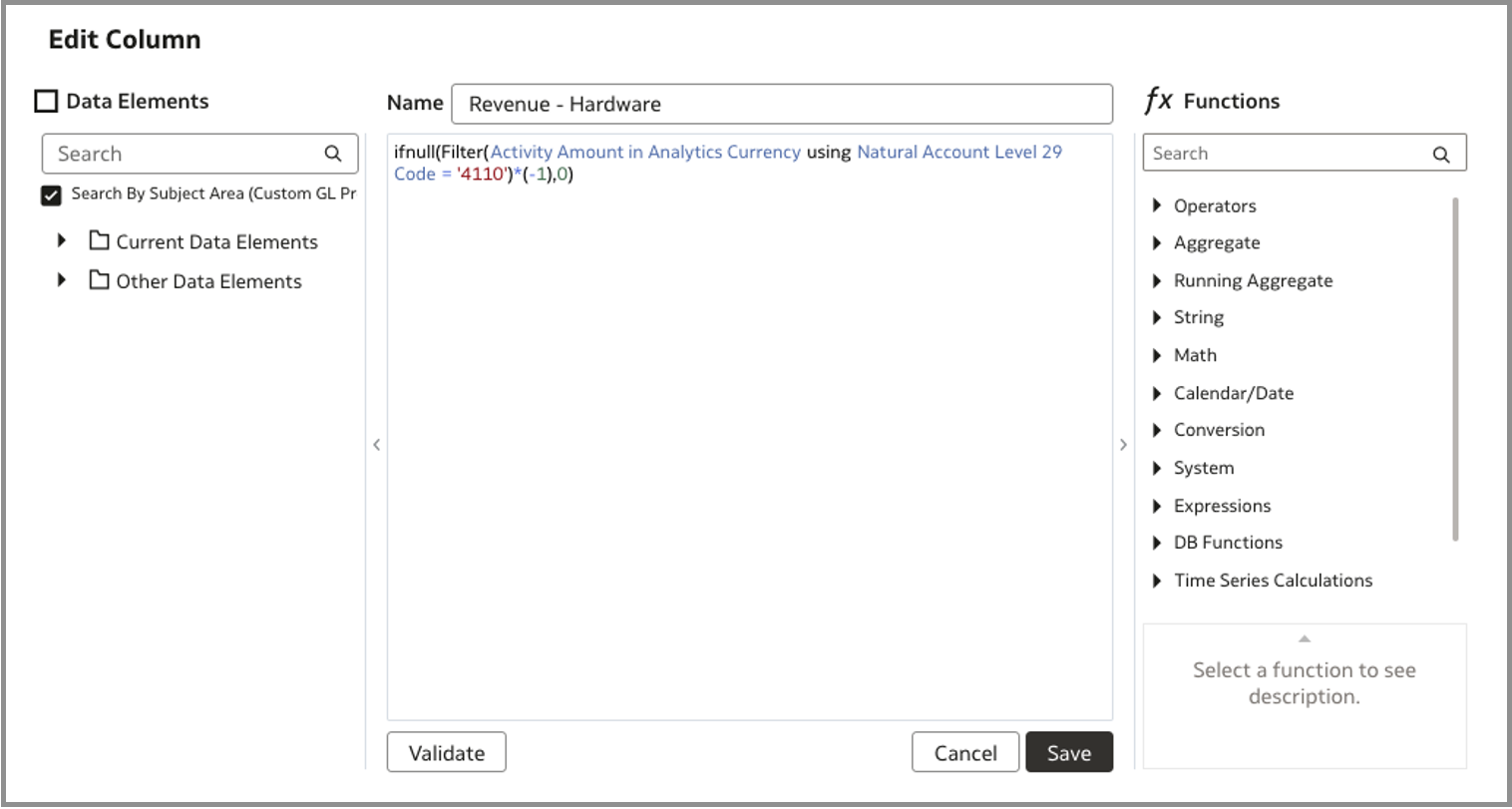
Revenue – Services
Enter the following formula:
IFNULL (FILTER ("Core"."Fact - Fins - GL Balance"."Activity Amount in Analytics Currency" using "Core"."Dim - Natural Account Hierarchy"."Natural Account Level 29 Code"= '4145')*(-1),0)

Revenue – Support
Enter the following formula:
IFNULL (FILTER ("Core"."Fact - Fins - GL Balance"."Activity Amount in Analytics Currency" using "Core"."Dim - Natural Account Hierarchy"."Natural Account Level 29 Code" = '4120')*(-1),0)
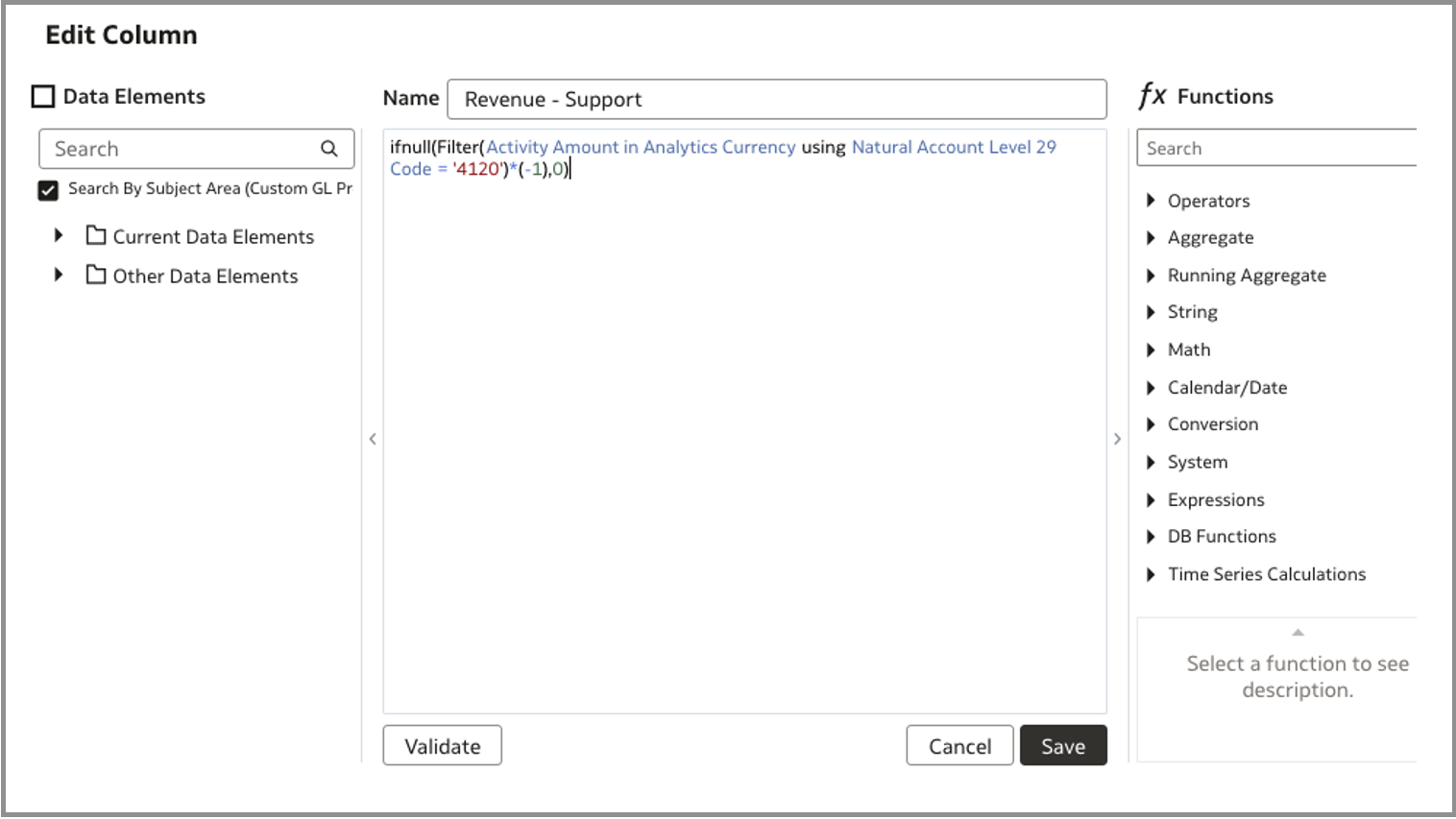
Revenue – Insurance
Enter the following formula:
IFNULL (FILTER ("Core"."Fact - Fins - GL Balance"."Activity Amount in Analytics Currency" using "Core"."Dim - Natural Account Hierarchy"."Natural Account Level 29 Code" = '4121')*(-1) ,0)+
IFNULL (FILTER ("Core"."Fact - Fins - GL Balance"."Activity Amount in Analytics Currency" using "Core"."Dim - Natural Account Hierarchy"."Natural Account Level 29 Code" = '4122')*(-1),0) +
IFNULL (FILTER ("Core"."Fact - Fins - GL Balance"."Activity Amount in Analytics Currency" using "Core"."Dim - Natural Account Hierarchy"."Natural Account Level 29 Code" = '4123')*(-1),0)
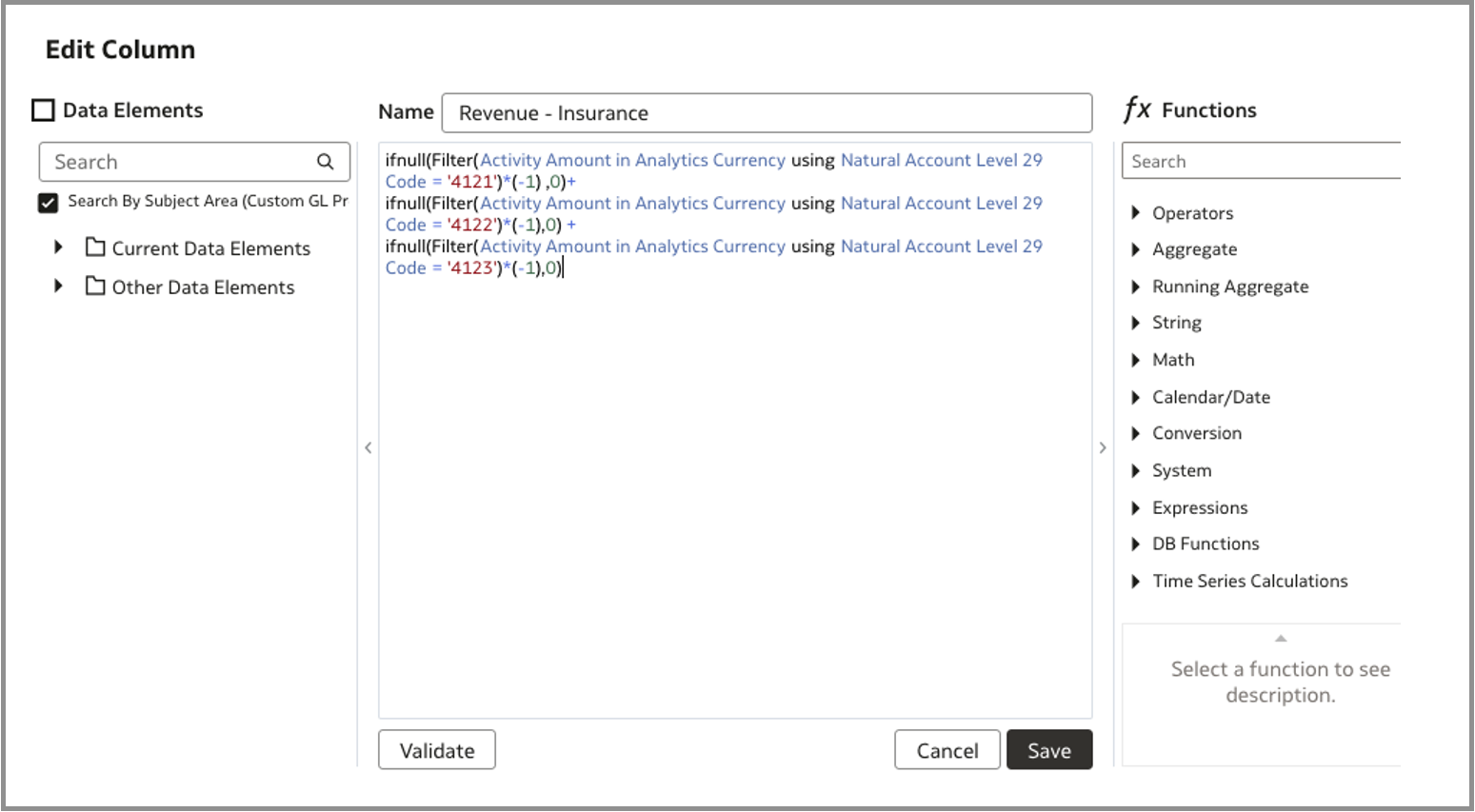
Revenue – Misc
Enter the following formula:
IFNULL (FILTER ("Core"."Fact - Fins - GL Balance"."Activity Amount in Analytics Currency" using "Core"."Dim - Natural Account Hierarchy"."Natural Account Level 29 Code" = '4150')*(-1),0)
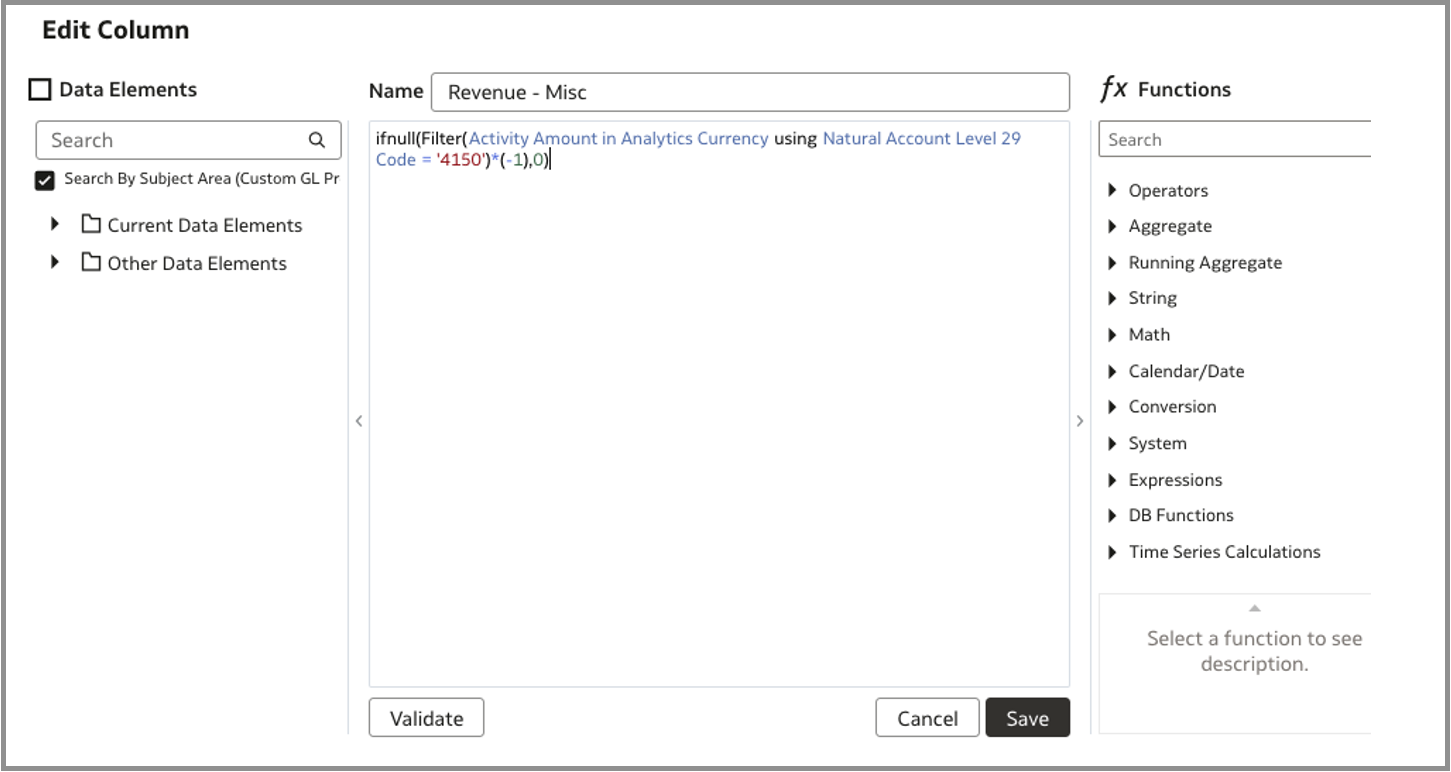
Revenue – I/C
Enter the following formula:
IFNULL (FILTER ("Core"."Fact - Fins - GL Balance"."Activity Amount in Analytics Currency" using "Core"."Dim - Natural Account Hierarchy"."Natural Account Level 29 Code" = '4160')*(-1),0)
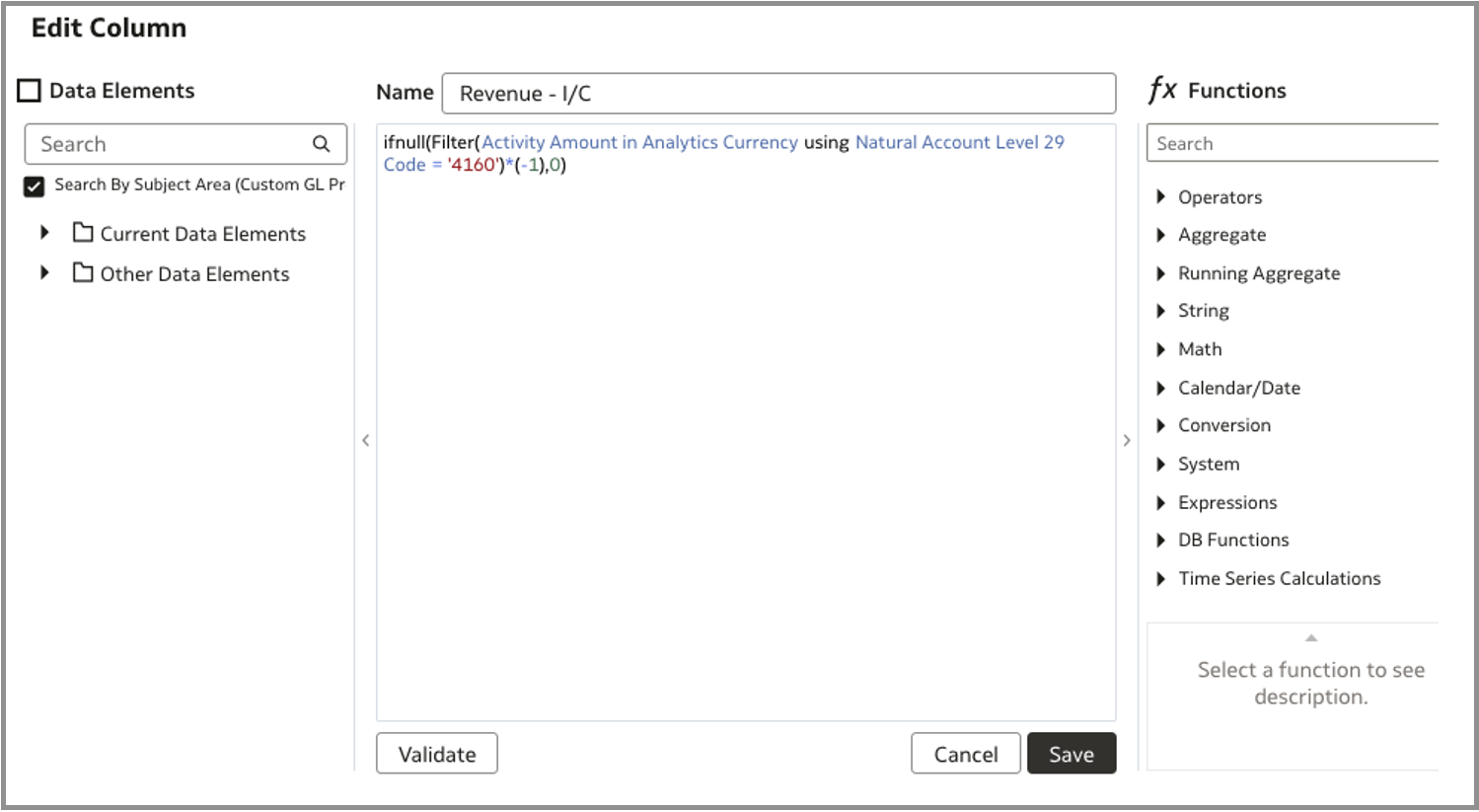
Total Revenue
Enter the following formula:
"Core"."Fact - Fins - GL Balance"."Revenue - Consulting" + "Core"."Fact - Fins - GL Balance"."Revenue - Hardware" + "Core"."Fact - Fins - GL Balance"."Revenue - Services" + "Core"."Fact - Fins - GL Balance"."Revenue - Support" + "Core"."Fact - Fins - GL Balance"."Revenue - Insurance" + "Core"."Fact - Fins - GL Balance"."Revenue - Misc" + "Core"."Fact - Fins - GL Balance"."Revenue - I/C"

Total Cost of Sales
Enter the following formula:
IFNULL (FILTER ("Core"."Fact - Fins - GL Balance"."Activity Amount in Analytics Currency" using "Core"."Dim - Natural Account Hierarchy"."Natural Account Level 29 Code" = '5000'),0)
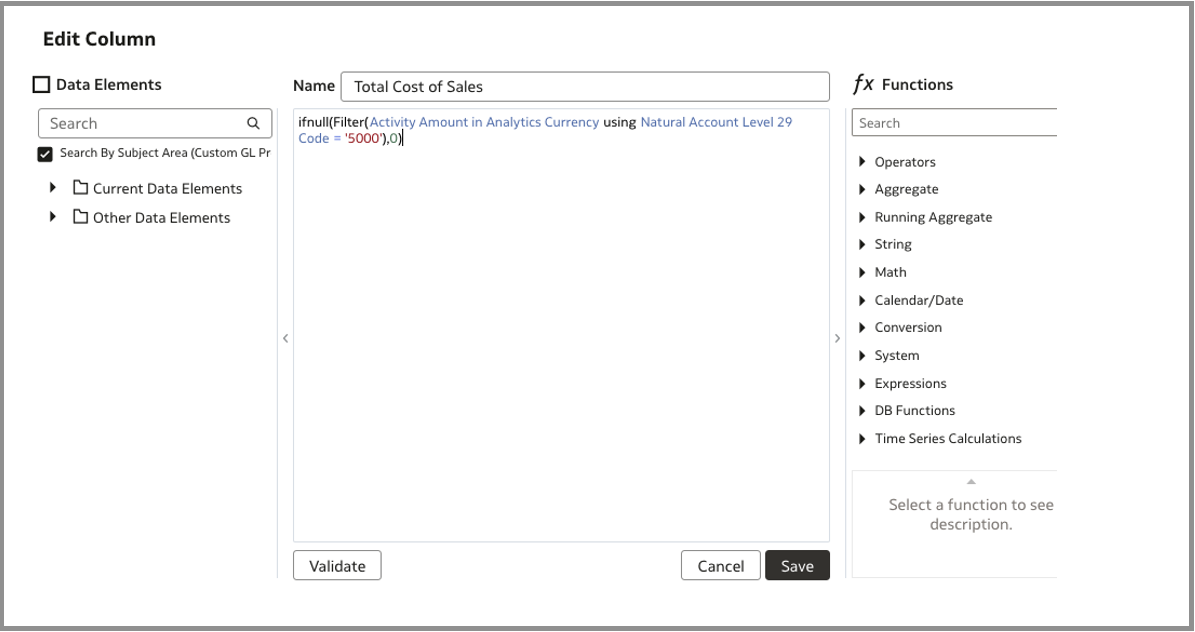
Gross Margin
Enter the following formula:
"Core"."Fact - Fins - GL Balance"."Total Revenue" - "Core"."Fact - Fins - GL Balance"."Total Cost of Sales"
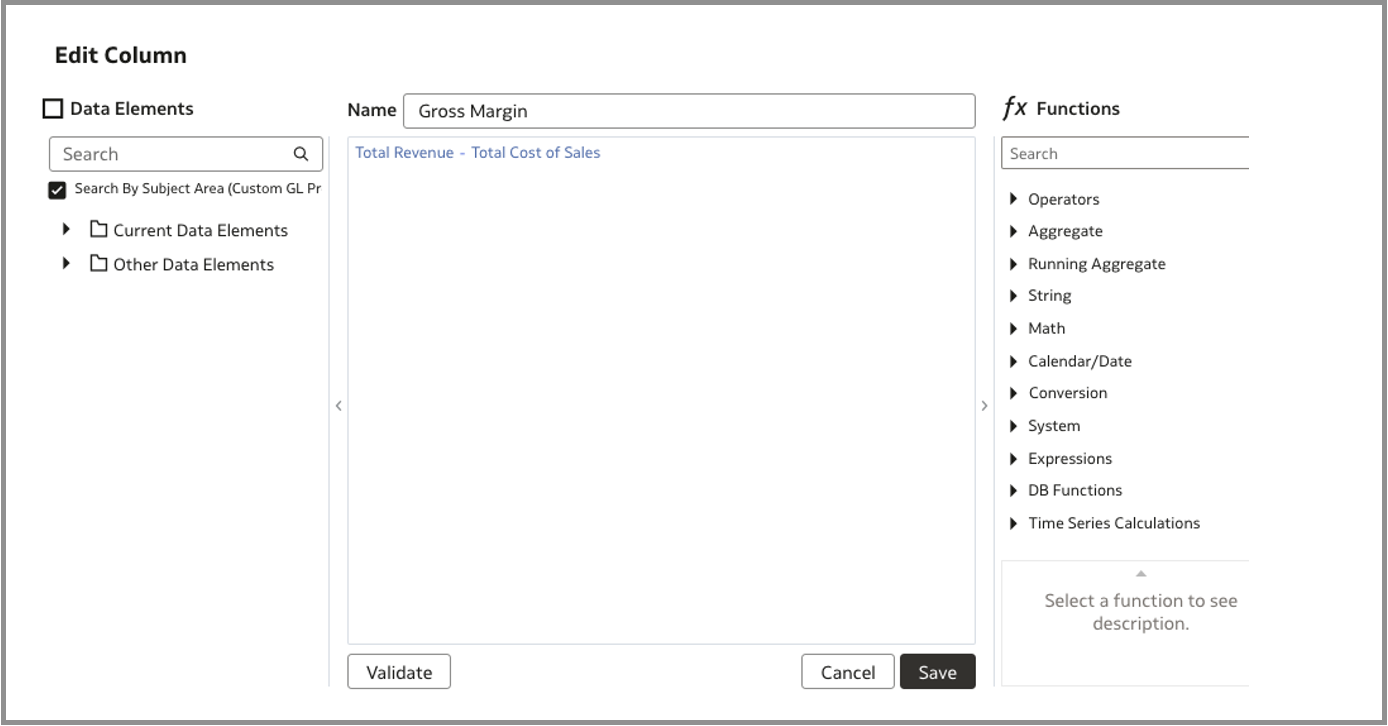
Click Save, Next, and Finish to complete the wizard.
To add the metrics to other subject areas, select them and click Finish.
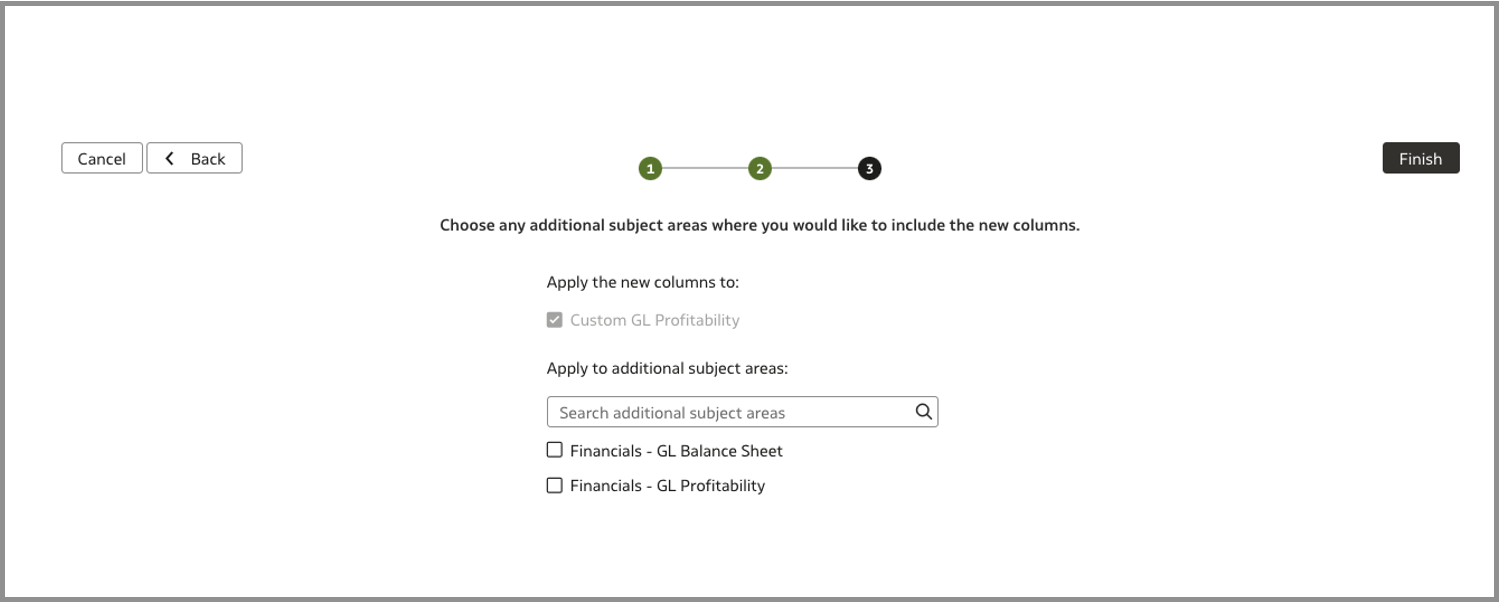
Use the Reorganization wizard to make other changes to this subject area.
For more information, check this article on Customizing Subject Areas in Fusion Data Intelligence.
Publish the Model
- Display the Semantic Model Extensions page and click Publish Model.
- Select Custom GL Metrics Based on Hierarchies from the User Extensions dropdown.
- Click Publish.
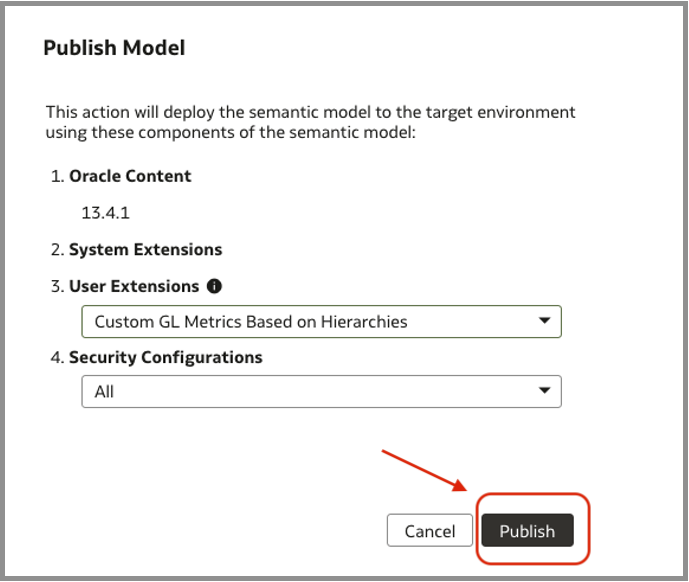
Create a Report
1. Create a report using the custom metrics.
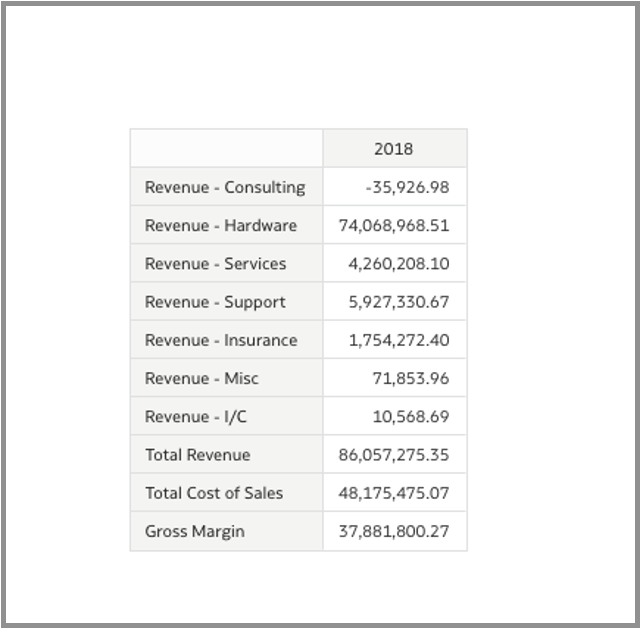
2. After validating them, click Merge to Main to merge it with the main branch.
Call to Action
For more details, see Customize Oracle Fusion Data Intelligence.
